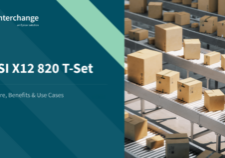How EDI-as-a-Service Changes Supply Chain Best Practices in 2021
Flexibility and agility have always been cornerstones of success, as recognised by 92% of c-level executives. Despite this, 27% admit that their enterprise is not as highly agile as they’d like it to be, a mistake that has proven fatal for many as the unexpected challenges of 2020 hit.
Now, as we adjust to a ‘new normal’ where the unexpected is expected, companies are realising that they need to overhaul processes, specifically within the supply chain, by putting simplified agility at the forefront. And, many are achieving this goal through updated EDI systems.
EDI (electronic data interchange) is a methodology for digitally transferring data, with a history stretching back as far as the 60s. It’s central to simplifying and standardising supply chains, and enabling the free flow of information within that supply chain. But legacy EDI systems struggle to accommodate a full range of global EDI standards and protocols — complicating flexible relationships between suppliers.
At Data Interchange, we’ve set out to change EDI best practices. By pulling together managed services and cloud-based tools, EDI can be updated to deliver a far smoother and streamlined process — and actually enable the kind of supply chain flexibility that EDI has always aimed to deliver. EDI-as-a-Service can transform how you approach supply chain risk and supply chain management. The question is, what is EDI-as-a-Service, and how can it change your supply chain strategy moving forward?
Suggested reading: For more information on how effective supply chain management can transform commercial outcomes, check out our ebook — The Supply Chain Centred Business.
What is EDI-as-a-Service?
EDI-as-a-Service is a 21st-century EDI overhaul that fundamentally aims to bring about digital supply chain transformations with the benefit of agility, simplicity, and ease of integration. When we refer to EDI-as-a-Service, we’re talking about flexible and inclusive cloud-based solutions, typically operating within a hybrid focus (pulling together multiple types of EDI) alongside the benefits of managed services and software-as-a-service.
Though people often use EDI-as-a-Service synonymously with hybrid EDI or SaaS, neither term covers the true scope of services on offer. Rather, this focus marries the best parts of a wide range of EDI possibilities within one single system, including:
- WebEDI tools
- Managed EDI services
- EDI via VAN
- Point-to-point EDI
- And more
EDI-as-a-Service harnesses SaaS tools to simplify access to EDI solutions, and deployed managed services (where needed) to help deliver EDI outcomes “as-a-service”. Where agility and strategic planning are concerned, the ease that these inclusive processes provide to even uncertain supply chains could soon become make-or-break. With that in mind, EDI-as-a-Service is a non-negotiable factor to putting supply chains, and thus continued service, at the business forefront at last.
Why EDI needs an upgrade
Historically, EDI has never truly delivered on the task it set out to resolve. In theory, EDI aims to provide two main things:
- Visibility by digitising and standardising the flow of information from one member of a supply chain to another the entire supply chain can be assessed, and plans can be made using up-to-date information.
- Optimisation through the automation of sharing and reviewing processes, efficiency is built into the system. By gaining better supply chain visibility, better choices can be made and the entire system more appropriately optimised.
However, several challenges typically stand in the way of both of these benefits, including:
- Incompatible protocols and standards: The wide range of EDI protocols (OFTP, AS2, FTP, etc.) and standards (EDIFACT, ASC X12, PEPPOL, VDA etc.) can be challenging to manage and limit any single EDI systems ability to function across a supply chain.
- Slow and complex onboarding: The range of EDI standards and protocols, along with legacy on-premise EDI solutions, can significantly complicate onboarding new partners — hampering supply chain flexibility.
- Siloed and corrupted information: The outcome of ad hoc and legacy EDI systems is siloed relationships and manual processes that can corrupt data and reduce the efficiency of your supply chain.
Inflexible and siloed EDI approaches especially pose problems for the communication that companies can’t do without right now. As such, the implementation of legacy EDI solutions can create impenetrable variations between trading partners. Worse, still, these challenges mean that manual processes will continue to be necessary for partners who don’t use EDI themselves.
As such, a hybrid approach is really the only way to achieve a broader implementation utilising varied standards and protocols, even with partners who have little-to-no EDI experience. That said, hybrid solutions on their own still fail to provide the unique EDI requirements to help you overcome the above setbacks altogether.
EDI-as-a-Service enables simplified access to tailor-made solutions that address specific EDI setbacks within your enterprise, whether that be through cloud-based implementations, fully-managed services, or a mixture of both. This ensures flexible accommodations that reduce the technical learning curve of EDI adoption for both you and your suppliers. This is the overhaul that EDI has been crying out for, and there’s never been a better time to take advantage of it.
Suggested reading: Our Plan at Data Interchange to Change EDI and Supply Chain Management.
How EDI-as-a-Service transforms supply chain management
The capabilities EDI-as-a-Service offers deliver much-needed supply chain transformations through a range of notable benefits, such as:
1. Simplicity
Complexity is an unwanted EDI addition that EDI-as-a-Service directly aims to simplify. Predominantly, this goal is achieved through the smooth integration of all supply chain processes, as well as cloud-based EDI focuses that ensure the easiest possible access from across the supply chain.
2. Visibility
Intended visibility hasn’t always worked out with traditional EDI implementation, but EDI-as-a-Service provides a one-source focus to digitisation with the help of dashboards and cloud-based tools. You get a single-source-of-truth that you can use to centralise access to supply chain information. You also get a system that is far simpler for supply chain partners to engage with — increasing adoption rates and delivering a more holistic picture of your supply chain.
3. Flexibility
Different protocols and standards across the supply chain have long prevented the EDI flexibility that companies have sought before now, but EDI-as-a-software addresses supply chain complexity by accommodating a wide range of protocols and standards automatically. This increased flexibility makes way for agile onboarding processes, regardless of whether suppliers have EDI experience or not.
4. Efficiency
At its heart, all EDI aims to provide efficiency to otherwise convoluted supply chains, but complex integrations have often caused further complications. The much simpler integrations possible with EDI-as-a-Service overcome this issue, and even remove the need for ongoing manual processes. With these benefits, it’s possible to tap into the EDI efficiency that should have been within reach all along, including:
- Increased profit margins that drive reinvestment
- Competitive advantages
- Improved strategic planning
- Differentiation methods beyond optimisation
5. Creative planning and control
All of these benefits, ultimately, lead to the all-important ability to plan and control within the larger scope of your supply chain. This, alone, is setting companies apart right now for two pressing reasons. For one, improved control and planning allow for better communication with your partners, thus improving relationships which are the touchstone to supply success. Equally, this benefit means that you can focus on improvements within your business bottom line, providing an altogether smoother supply experience than if you were distracted with those otherwise damaging EDI focuses.
Finding the right EDI partner
There’s no question that traditional EDI is not up to the challenge of 2021. EDI-as-a-Service offers the custom-made, service-led approach that businesses are looking for. Or, at least, it does if you find the right EDI partner who understands their place in your particular supply chain.
At Data Interchange, our 100+ EDI experts have over three decades of experience delivering tailored hybrid models via EDI-as-a-Service. Using SaaS tools to simplify EDI at every stage of your supply chain, our managed services are guaranteed to meet the needs of your partners and your business. In 2021, this is a competitive advantage you really can’t be without, so get in touch today to enjoy the simplified supply chain you’ve been dreaming of.
Additional reading: If you want to learn more about finding an EDI partner, check our list of 10 Things to Look For in an EDI Managed Service Provider.































































































































